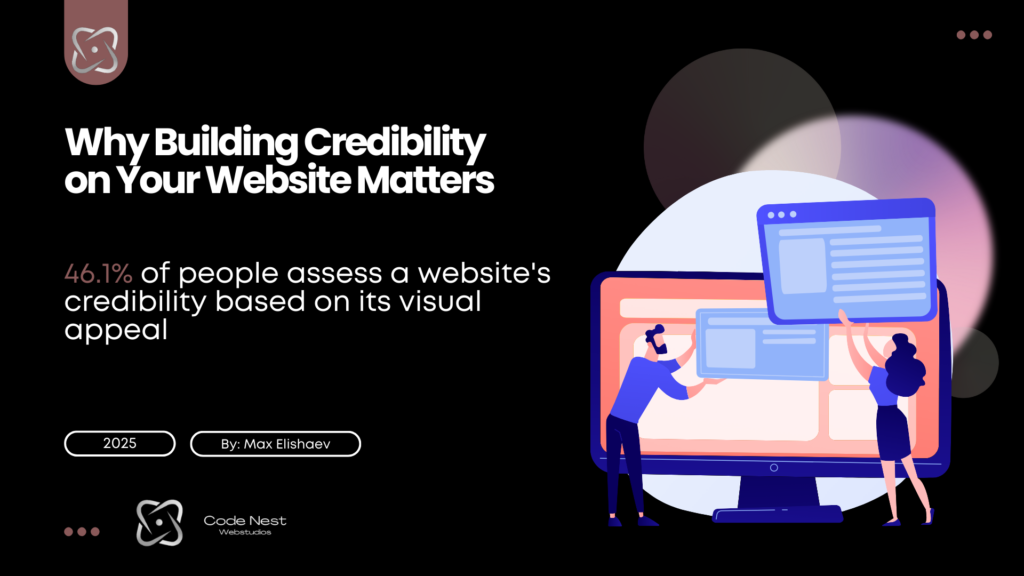Why Building Credibility on Your Website Matters

In today’s competitive online environment, your website isn’t just a digital storefront; it’s the foundation of your brand’s credibility. A lack of trust in your website can lead potential customers to abandon it in seconds, costing you valuable leads and sales. According to the Stanford Web Credibility Project, 46.1% of people judge a website’s credibility based on its visual design. In this blog post, we’ll explore why website credibility is essential in 2025 and how to build it effectively.
1. First Impressions Are Everything
When users land on your website, they form an opinion about your brand within 50 milliseconds. Factors like your site’s layout, typography, colors, and responsiveness all contribute to this snap judgment. In fact, a poorly designed website can make visitors question the legitimacy of your business.
Key tips to improve first impressions:
-
Use a clean, professional design.
-
Ensure fast loading speeds.
-
Optimize your site for mobile devices.
A visually appealing website signals professionalism, which is crucial for establishing trust.
2. Content Is King
The quality of your content plays a significant role in building credibility. Clear, informative, and relevant content shows that you understand your audience’s needs and can provide value.
Key strategies for content credibility:
-
Use accurate data and cite reliable sources.
-
Update your content regularly to keep it relevant.
-
Include detailed FAQs to address common customer concerns.
Content that resonates with your audience enhances your reputation as an authority in your industry.
3. Trust Signals Are Crucial
Trust signals are elements on your website that reassure visitors of your legitimacy. These include testimonials, reviews, and certifications. Websites with visible trust signals convert visitors into customers at higher rates.
Effective trust signals to include:
-
Customer testimonials with photos or videos.
-
Certifications, awards, and partnerships.
-
Secure payment badges and privacy policies.
For example, featuring recognizable security badges like SSL certificates increases users’ confidence in sharing personal information.
4. Consistency Builds Reliability
Brand consistency across your website reinforces your professionalism. Mismatched fonts, outdated logos, or inconsistencies between pages can confuse visitors and erode trust.
Tips for maintaining consistency:
-
Use the same logo, colors, and typography throughout your site.
-
Align your messaging with your overall brand voice.
-
Ensure every page has the same level of design quality.
Consistency shows that your business is reliable and detail-oriented.
5. Leverage Social Proof
Social proof, such as reviews and case studies, demonstrates that other people trust and value your products or services. According to BrightLocal, 88% of consumers trust online reviews as much as personal recommendations.
How to showcase social proof:
-
Highlight customer reviews and ratings prominently.
-
Share case studies that demonstrate successful outcomes.
-
Display social media mentions or user-generated content.
Social proof builds confidence in your offerings and encourages new customers to trust your brand.
6. Prioritize User Experience (UX)
User experience is at the heart of website credibility. A site that’s hard to navigate or cluttered with ads will drive visitors away.
Ways to improve UX:
-
Streamline your navigation menu.
-
Optimize for fast page loading speeds.
-
Ensure all links and features function properly.
A positive user experience keeps visitors engaged and builds trust over time.
7. Demonstrate Transparency
Transparency is critical for earning and maintaining trust. Websites that clearly state their policies and practices are more likely to win over skeptical users.
Key transparency practices:
-
Display a clear privacy policy.
-
Provide detailed contact information, including an address and phone number.
-
Be upfront about pricing, fees, and terms.
Visitors appreciate honesty and are more likely to trust businesses that are open about their operations.
Conclusion
In 2025, website credibility isn’t optional – it’s essential for success. By focusing on design, content quality, trust signals, and user experience, you can create a website that not only attracts visitors but also earns their trust. Remember, a credible website is the foundation of a thriving online presence. Invest in your site today to build lasting relationships with your audience and secure your brand’s future.

